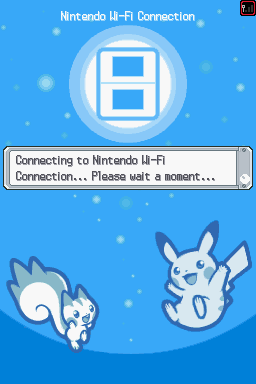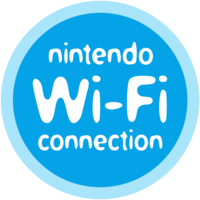Nintendo Wi-Fi Connection
Nintendo Wi-Fi Connection (Japanese: ニンテンドーWi-Fiコネクション Nintendo Wi-Fi Connection), also known as Nintendo WFC for short, was a service run by Nintendo that allowed free online play all over the world. It was used by Nintendo DS and Wii games. It was succeeded by Nintendo Network.
This service ended for Nintendo DS and Wii games on May 20, 2014.[1]
Features
Friend Codes
- Main article: Friend Code
Every game that utilized the Nintendo Wi-Fi connection required players to use a unique 12-digit code known as a Friend Code. It was generated when the player logged onto it for the first time, and it was used to identify other players on online play.
Buying games
The Wii allowed players to buy WiiWare and Virtual Console games from the Wii Shop Channel. Players had to use Nintendo Points, which were bought with real money.
The Nintendo DSi, on the other hand, allowed players to buy DSiWare games on the DSi Shop for Nintendo Points as well.
In the games

The first Pokémon games to utilize the Nintendo Wi-Fi Connection were Pokémon Diamond and Pearl, with Platinum following soon after.
Features
Nintendo Wi-Fi Connection allowed players to connect with the games of other players all over the world.
Features in the core series games
- The Global Terminal brought the most features to the core series, with the Global Trade Station and the ability to upload, view and download several types of data including full videos of battles. In Diamond and Pearl Versions, this facility is limited to the GTS.
- The Wi-Fi Club, for private online activity with friends registered in the player's Pal Pad. In Platinum, HeartGold and SoulSilver, players could partake in Battle Frontier challenges, games from the Wi-Fi Plaza, and spin trades, among other activities.
- The Wi-Fi Plaza allowed groups of up to 20 players to play three different games together online.
- Special key items, such as the Secret Key and Member Card could be downloaded to obtain additional Pokémon, items, features or areas. The exact dates in which these items are or were distributed may vary by region.
- Special Pokémon could be downloaded to trigger additional events and unlock certain Pokémon, items, features, areas, or aspects of the game's storyline. The exact dates in which these Pokémon are or were distributed may vary by region.
Features in the Pokémon Ranger series
- The Ranger Net in Pokémon Ranger: Shadows of Almia and Pokémon Ranger: Guardian Signs allowed players to download additional missions to their games to expand the storyline.
Features in the Pokémon Mystery Dungeon series
- In Pokémon Mystery Dungeon: Explorers of Time, Darkness, and Sky, players could send and receive requests for rescuing each other.
Other features
- Users can purchase and download additional software to their Nintendo DSi, Nintendo 3DS, or Wii.
- One application that can be downloaded allows users to browse the Internet on their DSi, 3DS, or TV.
- On these systems, it is also possible to download an update to the console's operating system to be able to use additional features, such as upload pictures taken on the Nintendo DSi Camera to Facebook.
- On the Wii, users could send messages to each other.
Games compatible with Wi-Fi
The following Pokémon games were compatible with the Wi-Fi Connection service before the service was discontinued. Certain titles, like Pokémon Conquest, may have had their online connections turn obsolete long before the overall service was discontinued.
Nintendo DS titles
- Pokémon Diamond and Pearl Versions
- Pokémon Platinum Version
- Pokémon HeartGold and SoulSilver Versions
- Pokémon Black and White Versions
- Pokémon Black and White Versions 2
- Pokémon Ranger: Shadows of Almia
- Pokémon Ranger: Guardian Signs
- Pokémon Mystery Dungeon: Explorers of Time and Explorers of Darkness
- Pokémon Mystery Dungeon: Explorers of Sky
- Pokémon Conquest
Wii titles
- Pokémon Battle Revolution
- Super Smash Bros. Brawl
- My Pokémon Ranch
- Pokémon Rumble
- Pokémon Mystery Dungeon (WiiWare)
External links
Notes

|
This game mechanic article is part of Project Games, a Bulbapedia project that aims to write comprehensive articles on the Pokémon games. |
